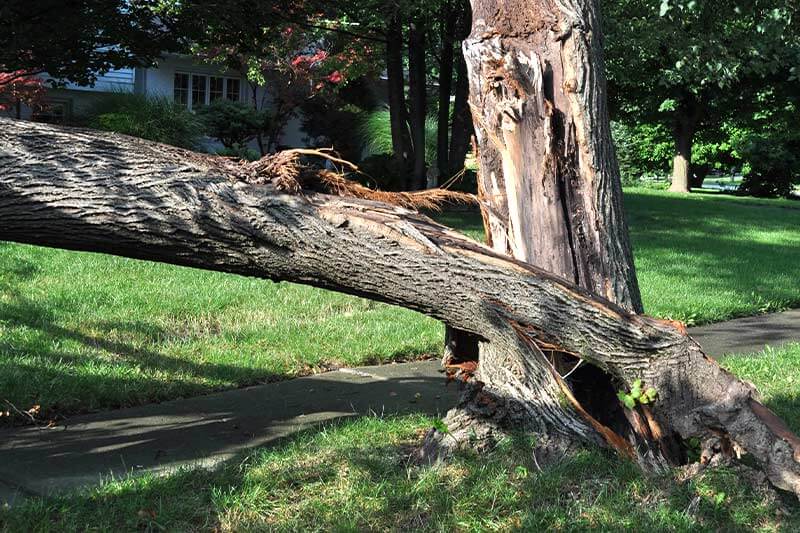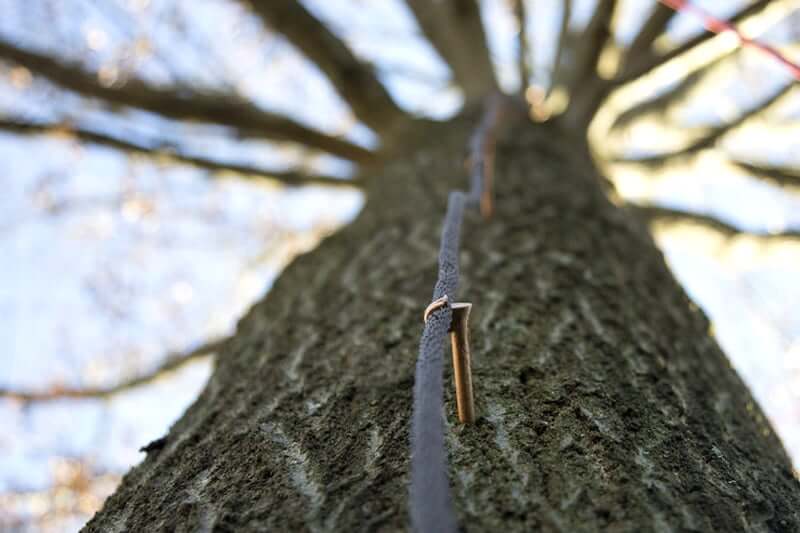A lightning strike on a tree can cause damage in different ways. Sometimes, a tree breaks or shatters when hit, some get burned, and others can blow off a strip of the tree’s bark.
As a rule of thumb, it should be removed when a tree dies or gets severely damaged after a lightning strike. This prevents other potential damage, especially when another storm comes.
Typically, a lightning strike can occur instantly and cause serious long-term problems for your tree and your property. When it occurs, below are some steps and precautions you can take to make your property more secure.

Tree inspection
- When there has been a storm in your area, you or a qualified arborist have to perform a tree inspection.
- Doing it involves finding a spot where lightning has struck your tree, and checking how much damage is visible. Signs of damage may include fallen branches, barks, or burning.
- Be careful not to attempt to push or shake the tree just to check its stability. Doing so might cause some branches or even the tree itself to collapse and cause serious harm.
- Limit your inspection to a visual inspection. One key sign to look out for is a lightning scar. A lightning scar is usually a bare part of the tree, caused by the stripping of bark due to a lightning strike.
- A lightning scar causes the tree to be prone to insect infestation and disease. If you spot one, contact your local arborist for a bark repair.
Tree pruning
- Once you spot that your tree has received serious damage because of a lightning strike, you may need to seek tree pruning.
- Damaged tree branches do not necessarily indicate that the tree is dead. Tree services may just prune the damaged sections and help keep the tree alive.
- Sometimes, there will be damage that you cannot spot from the ground. Tree removal companies will inspect these using special equipment, and their workers will remove any potential debris.
Leaf checks
- Oftentimes on the days that follow a storm, you can determine if the tree is healthy and alive based on its leaves.
- Sometimes, a lightning strike can penetrate the ground and damage all the roots of the tree. By examining the health of the leaves, you can determine the health of the tree.
- Additionally, if your tree has been hit by lightning, a dying tree will have withered leaves on all its branches. Loss of color is likely to appear.
- If left unattended, the tree will gradually rot from the inside and will develop more dangers if the tree can no longer sustain itself.
- You can also examine the surrounding plants as well. Most of the time, the damage of the lightning strike will affect the other plants and flowers.
Tree removal
- When a tree dies because of a lightning strike, it should be removed.
- If the tree has significant splinters and large parts of the tree are missing, then a tree removal comes necessary.
- If a storm comes again or in areas that suffer strong winds, the damaged tree might fall over and cause more damage to your property or your family.
- With a tree removal company’s services, professional removal of the tree will take place. Stump removal will help remove the entire trunk and ensure that all parts of the tree are removed.
- Most of the time, these companies will also have emergency services, especially when the tree shows large and heavy damage. This includes same-day services that will tend to repair or remove problems.
To save your tree that has been struck by lightning, it’s necessary to take swift action. Most of the time, trees that are struck by lightning will continue to live with, or without repair; however, there are important steps that you need to take.
However, not all trees can be saved, and there can be multiple instances where lightning-struck trees still pose harm to your family or property. With this, you must consult a certified professional arborist for your needs. For information on arborists and their potential cost, visit our homepage for links to more articles.
Can lightning strikes on a tree be prevented?
Luckily, yes. Some methods can be applied to help you prevent your trees from getting hit by lightning, and it is better to adapt this from early on instead of repairing the damage afterward.
Lighting protection measures can be installed to help protect your important or even just vulnerable trees. These can help protect trees by slowly releasing electrical charges, making them dissipate. This makes it less harmful.

Lightning protection systems to adapt or install
Preventive measures involve an air terminal placed on top of the tree, a ground-rod system that is placed at a safe distance from the tree, and a copper cable conductor that follows the trunk of the tree down to the ground.
With this mechanism, lightning that strikes the tree and its current will direct its charge along the cable and away from the protected tree, making its dangerous electric current dissipate safely under the ground.
Lightning protection systems installed in trees do not necessarily attract lightning. These protection systems dissipate the electrical charge from the lightning before it can build to high levels.
Its purpose is to slowly release and dilute the electrical charge potential between the cloud and the ground where the tree is situated.
It is important to consult and seek the professional service of your local trained arborist or an urban forester before you have a lightning protection system installed.











